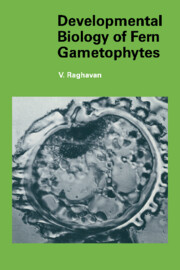Book contents
- Frontmatter
- Contents
- Preface
- Abbreviations
- 1 Introduction
- PART I THE BEGINNING
- PART II GROWTH AND MATURATION
- PART III REPRODUCTIVE STRATEGIES
- PART IV DEVELOPMENTAL OPTIONS
- 13 Apogamy – an alternate developmental program of gametophytes
- 14 Apospory – formation of gametophytes without meiosis
- References
- Author index
- Subject index
14 - Apospory – formation of gametophytes without meiosis
Published online by Cambridge University Press: 11 September 2009
- Frontmatter
- Contents
- Preface
- Abbreviations
- 1 Introduction
- PART I THE BEGINNING
- PART II GROWTH AND MATURATION
- PART III REPRODUCTIVE STRATEGIES
- PART IV DEVELOPMENTAL OPTIONS
- 13 Apogamy – an alternate developmental program of gametophytes
- 14 Apospory – formation of gametophytes without meiosis
- References
- Author index
- Subject index
Summary
While the gametophyte featured in our previous discussions is born out of a reduction division of the sporocyte, in this final chapter we will pay some attention to the development of gametophytes directly from sporophytic tissues bypassing meiosis.
The reproductive strategy which results in the generation of gametophytes without meiosis or sporulation is a facultative property of sporophytic tissues of certain homosporous ferns and is known as apospory. Aposporously formed gametophytes grow without any restrictions and behave in every respect like those evolved from germinated spores except that their germ cells display the same chromosome number as the sporophyte. For this reason, apospory is considered to account for the natural polyploidization in ferns, although other factors might also be involved. Unlike apogamy, apospory is of sporadic occurrence in nature and only a few ferns have been shown to display this phenomenon consistently in their life cycle. However, aposporous regeneration of gametophytes is readily induced when different parts of the sporophyte are challenged by simple manipulative or cultural techniques. The early work on apospory has been reviewed by Steil (1939, 1951).
Although Steil (1939) considers apospory in a broad sense to include the formation, without meiosis, of rhizoids, gametophytic cells, sex organs or sperm on the sporophyte, the term will be used in this book in a restricted sense to include regeneration from the sporophytic tissue of a more or less complete gametophyte that perpetuates a persistent diploid genome in its cells.
- Type
- Chapter
- Information
- Developmental Biology of Fern Gametophytes , pp. 280 - 295Publisher: Cambridge University PressPrint publication year: 1989
- 1
- Cited by



